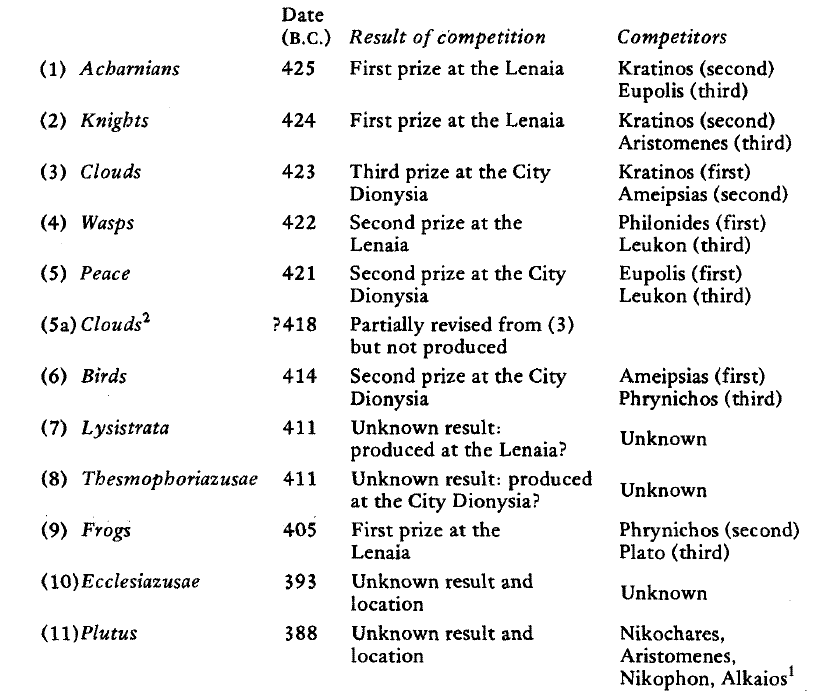No CrossRef data available.
Article contents
II. Titles and Chronology
Published online by Cambridge University Press: 05 February 2016
Extract
The plays that have survived into modern times are these:

This information is derived from the hypotheses (introductory summaries, Hellenistic and Byzantine, with extracts from the official public record of performances) prefixed in manuscripts to all the plays: those in Thesmophoriazusae and Ecclesiazusae are truncated. Thesmophoriazusae is datable, however, by its mention of (a) ‘last year’s council’ (the Council of Five Hundred, 413/12); (b) the play of Euripides produced ‘last year in this same place’ (Andromeda, City Dionysia, 412); Ecclesiazusae refers to ‘this alliance’ (the pact between Thebes and Athens, 396/5), and a scholion, quoting Philochoros, dates the play two years before it (394/3). This is consistent with Praxag-ora’s allusions to the current situation (E. 195 ff.).
- Type
- Research Article
- Information
- Copyright
- Copyright © The Classical Association 1979
References
Notes
1. Notice the post-war presentation of five comedies (Hypothesis IV, Plutus, 1-3) as against the three during the war years. This (the common opinion) has been challenged by arguments for five throughout the period: Luppe, W., ‘Die Zahl der Konkurrenten an den komischen Agonen zur zeit des Peloponnesischen Krieges’, Pbilologus 116 (1972), 53-75.Google Scholar
2. The metrical hypotheses are attributed to Aristophanes of Byzantium. See Koster, W.J.W., ‘De Aristophane Byzantio argumentorum metricorum auctore’ (Charisteria F. Novotný, Prague, 1962), pp. 45–8 Google Scholar. His authorship is denied (justifiably) on grounds of content and metre: Nauck, A., Aristophanis Byzantii Alexandrini Fragmenta (Halle, 1848, repr. Hildesheim, 1963), p. 256 Google Scholar; Grobl, J.N., Die ältesten Hypotheseis zu Aristophanes (Dillingen, 1889-90), pp. 12–13 Google Scholar; Boudreaux, P., Le Texte d’Aristophane et ses commentateurs (Paris, 1919), p. 31 Google Scholar.
3. T. 808 ff.; 1059-61.
4. E. 193, Philoch. 328 F 148.
5. The only internal evidence is C. 528-33 (he was ‘too young’ to produce a play himself in 427). External evidence is (a) schol. F. 501 (he began his career σχεδον μειρακισκος)1 (b) Suda s.v. Άριστοφάντις (which would seem to put his birth in 443). Eupolis allegedly produced his first play at seventeen (Suda s.v. Εύ’πολις); but Banqueters, with its intellectual theme like that of Clouds, is surprising from such a youthful playwright.
6. See (for his diffidence) K. 514 ff.; (for Kallistratos as producer of these plays) Anon. De Com, 11. 44; Suda β.ν.Σαμίων ò δήμος; Hypothesis I, Acharnions, 30. Plato Comicus also for a time entrusted his comedies to others (P. Oxy. XXXV. 2737, fr. 1. ii. 12 ff.).
7. K. 512-14.
8. Hypothesis I, Birds, 7, 11.24; Hypothesis II, Birds, 24-5, Hypothesis I, Frogs, 29-30.
9. Hypothesis IV, Plutus.




